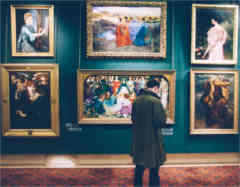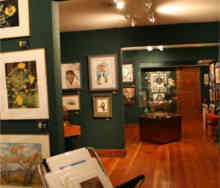What Is Art Nouveau? The Counter Culture Art
Art Nouveau began as a movement against the established academic art and historicism of the 1800’s. It did not take long for names like Aubrey Beardsley and Gustav Klimt to be known.
This 1890’s influence was impacting home design and architecture albeit for a very brief period of time. Brussels is where the first homes of this style were designed and built.

It is amazing that Nouveau matured and disappeared in such a short time span. A mere 20 years from 1890 to 1910 is where its dominant influence is to be found.
By 1914 with the onset of World War 1 the sun had set on Art Nouveau. A rapid transition had begun to something new due to rapidly changing times.
One could ask how an art movement gave such quick rise to then suddenly decline. This was not a common phenomenon.
Its focus had served to be a statement against the established arts. The world itself was beginning to shed the Monarchist mindset and gravitate towards the common man.
Characteristics Of Art Nouveau To Culture
As Art Nouveau came near the end of the Victorian Era it would embody the cultural shifts that would soon take over the world.
Nouveau could be seen in many different nations across Europe. Each nation would have its own localized name within that culture.
The primary art form was more geometric in its design and less defined by realism. Much influence was derived from Japanese art which was also coming into popularity at this time.
It may surprise some that Wood Burning Art thrived in this period and continued forward into the early 1900’s. This art form was most commonly found within Europe during the Art Nouveau period.
Painting and sculpting is where Nouveau was most popular. Although it was used across many applied arts, the influence did not have a long enough life to grow deeper roots.
From its peak the influence of Nouveau did not last a full generation.
While its life was limited it would hold influence for later generations and applied art. It would be in the 1960s with a different counter culture that appreciation would return to this art style.
Here in this same period we also would see an additional rise in appreciation for Japanese art forms. Black and white Zen Art would share popularity between two generations separated by seventy years.
The Art Nouveau rebirth in the 1960’s would use natural forms within its art. Plants and flowers were common and asymmetric in their application.
In less than 100 years two different counter cultures found meaning within this art. Each time it was used as a statement against the establishment.
What Is Art Deco?
The rise of Art Deco can be found from World War 1 and forward to about 1937. Its birth was closer to 1900 yet took time to gain in popularity.
This era would bring many new ideas that we still know today. Some like Concept Art is still alive as a major industry thanks to this period of history.

In this era, industrial applications became the focus of society. There was a desire to return to definition and genuine craftsmanship.
Deco was broadly accepted in France where its greatest influence was found in architecture. The skylines of major cities would have their buildings modeled with its clean lines.
With this movement it would also influence painting, sculpting, jewelry and a host of other arts. Its founding can be traced to craftsmen and artists at the turn of the century.
Near 1901 these individuals became noticed for their influence of design within homes and buildings. It could be said to be the birthplace of interior designers.
Characteristics Of Art Deco To Culture
It would not take long for furniture and home styles to follow this new era of design. While still geometric in its form for practical purposes, it was more refined and detailed than its preceding Art Nouveau.
It can at times be easy for people to mistake work from these two periods as being the same. Nevertheless their differences are in refinement and application.
There is one major contrast from the Art Deco in the early 1900s to that of our time today. At its onset only the best materials which money could buy would be utilized.
In other words while it was decor mixed with design, it was also associated with luxury. These pieces were about elegance not mass production for the common man.
Furniture would include jade, silver, and gold inlay. Diamonds were also often used to add beauty and value to a piece.
This era of artistry is often associated with the Roaring 20’s. Ocean liners such as the Titanic became the early models of this indulgence into all things extravagant.
Each new feat of engineering would attempt to rival the one before it.
The Decline Of Art Deco
The decline of Art Deco would begin with the Great Depression. Here things became more practical and somber as the economies of the world would begin to suffer.
With the onset of World War 2 and greater industrialization, less expensive materials such as modern concrete became commonplace. Other extravagant items from the early 1900s begin to disappear or be mass produced.
An example of this transition can be found within some of the opulent features of the Titanic. What was once extravagant would be no more.
The Grand Staircase of the Titanic had a beautiful floor at its base. The material used in its time was considered extravagant and only the rich would have the same flooring.
Today it is common within mobile homes and we know it as linoleum. More change took place from 1900 to 1950 than the previous two hundred years.

Industrial efforts adopted practical design applications and left the Art Deco behind. By the 1960s Art Deco was being rendered to nothing more than the style of the time.
The gold and silver inlay for furniture was gone and opulence was left for function.
Prices for what was once extravagant due to industrial design was made commonplace. Mass manufacturing would opt for volume in sales as compared to limited items at higher prices.
Interior decorators which once was a specialist job type for elite artisans, was open to anyone with some experience or a degree.
Marketing would use these older terms to herald those days in an attempt to promote their items. Unfortunately there was little special about that item.
Plastics and manufactured woods would replace what was once artisan made. Arts and crafts would soon adopt these same marketing words rendering the traditional Art Deco ideas dead.
Much would be forgotten to history.
Despite its pure origin being forever removed there is no doubt its influences are still felt. Monochromatic art is one example of what these transitions through time gave us.
Art Deco Within The Age Of Technology
In our world today the term Art Deco is used as frequently as home decor. The traditional meaning from its inception has been completely lost to time.
Anyone with an internet connection and an opinion on a blog can front as being a specialist as an interior decorator. That is an interesting fall from what was once reserved for more elite artisans.
Few interior decorators now can put together arts or crafts much less claim to be an artist of any type. Makers have taken over the scene with cheap decor which is not much more than the crafts hobby enjoyed by many in retirement.
The only real difference is scale of production when compared to the hobbyist.

There are elite makers who trend more towards art, but they are few in number. Artists today find themselves in an ever more competitive world where cheap design and make are often favored over quality.
In the beginning when artists set forward on a path with Art Deco it was an ingenious concept to bring art into design. It was profitable and allowed for cultural definition breaking away from Classical ideas.
The transition from Art Nouveau helped bring a new standard to industrialized efforts and design concepts grew by leaps and bounds as a result.
There is no doubt that society has benefited from these foundations. The skylines of our cities show the history of this development.
Nevertheless somewhere along the way the artist was left behind. Today we wish to go back to what is a more pure form of appreciation of art for what it is.
Impact On Modern Art
Nouveau art has left its imprint on modern art. Today we use other words to help define it in our time.
We will often call it stylized art but its roots can trace back to Art Nouveau. There are many other art concepts which also fall into this stylized categorization.
Despite this broader category the roots can be seen within many geometrical pieces. Further transformation has taken place within different aspects of abstract art which exists on the extreme end of the stylized art forms.

Both Nouveau and the original Art Deco existed on the same scale. Art Deco leaned more to realism with its defined lines and refinement.
Despite the many years between the origins in these arts, the culture that gave birth to them remains. Abstract and stylized forms are often seen as counter culture to the more realist structured art of today.
With this culture comes the age old argument where the abstract would claim everything is art and a realist would disagree. Philosophical ideas of art being about life, or life about art are seen differently today than in the past.
Technology had brought a new age within art. There is no doubt that there is no other art form we can presently call more modern than Digital.
This New Media Art will never completely replace traditional arts yet its force within the world is irrefutable.

Due to technology we find further deepening of division with the argument of design vs art. Or rather is art also design?
Within our present world we do not have a specified era. We are not Victorian, nor Nouveau, and Art Deco is gone.
If we are to be classified anything it is a Digital Age of Art. Yet within it all the old world concepts seem to collide at an intensity and speed that before would take generations to cultivate.
It at times seems as if our art today is almost an anything goes mentality. It will be interesting to see what the future brings with the influences that will come.
Behind it all will still remain the driving force of culture as to its classification. We are presently within the single greatest melting pot of ideas which history has ever seen.
